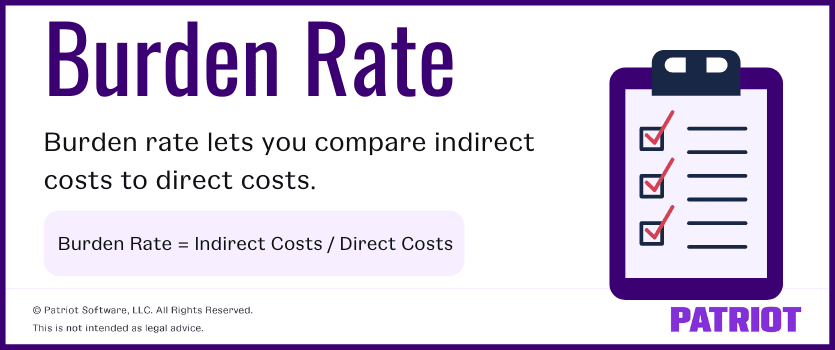Running a business has some indirect costs. These costs aren’t always apparent, which is why they’re the hidden costs of running a business. It’s important to keep track of your business’s indirect costs. And, you should know how your indirect costs compare to your direct costs. To do this, you’ll need to find your burden rate.
What is burden rate?
The burden rate is a way to compare indirect costs to direct costs. It is commonly used to calculate the indirect costs of having employees and manufacturing inventory. Burden rate sometimes goes by other names. You might see it as factory overhead, manufacturing burden, indirect production costs, labor burden, or other similar terms.

When to use burden rate
As mentioned before, you will typically use burden rate to find the indirect costs of your labor force or inventory.
Labor
To calculate labor burden rate, you must first total your indirect costs. The indirect costs are anything beyond an employee’s gross compensation. For example, indirect costs might include employment taxes, workers’ compensation, health insurance, and paid time off.
To get the labor burden rate, you will divide the indirect costs by the direct cost of payroll.
Labor Burden Rate = Indirect Costs / Direct Payroll Costs
The burden rate is a dollar amount, which is the dollars of labor burden per one dollar of wages. For example, a burden rate of $0.50 means you spend $0.50 on indirect labor costs for every dollar of gross wages you pay.
Let’s say you pay an employee $40,000 per year. The annual payroll taxes and benefits associated with this employee total $10,000. To get the burden rate for this employee, divide the indirect costs by the direct costs.
$10,000 / $40,000 = $0.25
The burden rate is $0.25. This means you pay $0.25 in indirect costs for every dollar of gross wages you pay the employee.
Inventory
To determine your burden rate, you first need to know how much you spend on material expenses for a product. Add those up.
You also need to know the production total you want the burden rate for. You might calculate the production total using labor, equipment capacity, or production hours. For example, let’s say you have a machine that can make 10 of your product per hour. If you run the machine for six hours per day and five days per week, you can make 15,600 copies of your product per year (10 x 6 x 5 x 52). Your production total is 15,600.
To get the burden rate, divide the material expenses by the production total.
Overhead Burden Rate = Material Expenses / Production Total
Let’s use the example of the machine above that makes 15,600 copies of your product per year. The material expenses for your product equal $50,000.
50,000 / 15,600 = 3.21
Your burden rate is 3.21, meaning you need to make at least $3.21 per product to cover the material expenses.
The benefits of calculating burden rate
Now that you know how to calculate burden rate, you need to know what you can do with your results.
The labor burden rate can help you understand how much an employee costs. The burden rate can help you decide if you can afford certain benefits.
With the overhead burden rate, you can discover how much your products really cost to make. You can determine the bare minimum you must sell them for. And, you can use the burden rate to get a better picture of how different materials and manufacturing costs will affect the total cost to produce a product.
Get a better handle on your small business’s finances. Use easy-to-use accounting software designed with small businesses in mind. You can easily see incoming and outgoing funds. Start your free trial.
This article has been updated from its original publication date of December 28, 2017.
This is not intended as legal advice; for more information, please click here.


